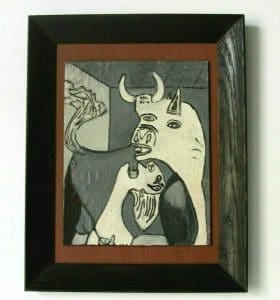
“Picasso’s Guernica Bull and Mother” by Robert MacDonald
In May of 2001, I packed my paints, canvas, clothes, and headed on my Pasaje Picasso which would end up taking me to just about every significant place where Picasso lived and created his art. Including Malaga, Picasso’s birthplace.
After seeing and studying Guernica at the Museo Reina Sofia, Madrid, I went on to visit the town of Guernica (with cousin Duncan McLeod). I later studied the many photos taken of “Guernica by Picasso’s Mistress Dora Marr – taken during Picasso’s painting of “Guernica”.
While on a return trip to Madrid, I was inspired to paint “Picasso’s Guernica Bull and Mother” (2001). As well as being painted in Madrid, I purchased the paint and canvas panel there.
 The picture on the left shows where I painted “Picasso’s Guernica Bull and Mother” at the early stages. It was outside my room with the little balcony in Madrid. Just down from the “Museo Reina Sofia.”
The picture on the left shows where I painted “Picasso’s Guernica Bull and Mother” at the early stages. It was outside my room with the little balcony in Madrid. Just down from the “Museo Reina Sofia.”
The Bull and The Weeping Woman in Picasso’s Guernica: Symbolism and Significance
In art, specific images resonate far beyond their immediate visual impact, embodying evolving layers of meaning. One such image is the bull in Pablo Picasso’s Guernica. This work has become synonymous with the horrors of war, the devastation of human suffering, and the ongoing struggle for peace. Robert MacDonald’s Framed Wood Painting of Picasso’s Guernica Bull provides a unique entry point to examine the bull’s role in Picasso’s masterpiece and how the symbolism embedded within the original work continues to captivate artists and viewers alike. In addition to the bull, another central figure in Guernica—the Weeping Woman—offers a profound commentary on the emotional and psychological toll of war, further enriching the broader meaning of the work.
Guernica – A Masterpiece of Political Protest
Created in 1937, Picasso’s Guernica is one of the most potent anti-war works of art ever produced. Painted in response to the brutal bombing of the Spanish town of Guernica by Nazi German and Italian fascist forces during the Spanish Civil War, the mural-sized painting depicts the chaos and suffering inflicted on innocent civilians. In this harrowing portrayal, Picasso employs a blend of abstract forms, anguished faces, and surreal distortions to communicate the widespread trauma of war.
Among the central figures in the piece are the bull and the Weeping Woman, two key symbols that deepen the work’s emotional impact. The bull’s ambiguous role and the Weeping Woman’s grief-laden expression reflect the broader themes of destruction, suffering, and resistance that permeate the painting.
The Bull in Guernica – Symbolism and Meaning
The bull, as a symbol, has deep roots in Spanish culture. It is frequently associated with bullfighting, a controversial but long-standing tradition in Spain, where the bull symbolizes strength and victimhood. In Guernica, however, Picasso does not depict a bull in a celebratory or heroic light. Instead, the bull appears as a somber, enigmatic figure, its gaze haunting and its posture ambiguous.
The Bull as a Symbol of Spanish Identity: In Spanish art and culture, the bull is often seen as a symbol of national pride, virility, and resilience. However, in Guernica, Picasso subverts this traditional symbolism. Rather than glorifying the bull as a symbol of Spanish power, he renders it as a tragic figure caught in the chaos and destruction of the bombing. The bull’s expression is ambiguous, and it is unclear whether it is witnessing the suffering or actively partaking in it. This ambiguity invites multiple interpretations, one of which could be that the bull represents the passive endurance of Spain itself—caught between the forces of war and its own national identity.
The Bull as a Symbol of Brutality and Suffering: The bull in Guernica has been interpreted as a representation of the brutality of war itself. While the bull traditionally symbolizes strength, in Guernica, Picasso presents it as an emblem of suffering, stripped of its usual nobility. The bull’s fragmented body and contorted form parallel the shattered, disjointed nature of the other figures in the painting—wounded civilians, a grieving mother, and dismembered bodies. The animal, much like the civilians, is both a victim and symbol of violence, a silent observer of the carnage, trapped in a cycle of destruction that it cannot escape.
The Bull as a Reflection of Power and Resistance: Finally, the bull can also be seen as a metaphor for power—both the power of the oppressors who carry out the violence and the strength required to resist such forces. In this reading, the bull could represent the strength of the Spanish people, enduring the brutality of war and fascism. Its gaze is often interpreted as sadness, but it also has an inherent resilience, suggesting survival amidst suffering. In this context, the bull’s continued presence in the face of devastation might symbolize a form of resistance, a reminder that strength can endure, even in the darkest of times.
The Weeping Woman in Guernica – Symbolism and Meaning
Equally poignant in Guernica is the image of the Weeping Woman, whose face is fragmented and distorted, amplifying the pain and sorrow that war brings. Positioned in the lower right corner of the painting, the Weeping Woman gazes upwards with a look of anguish, her mouth agape in a silent scream. Her figure starkly contrasts the more abstract forms of other characters, giving her an intensely human presence within the surreal landscape of Guernica. The Weeping Woman is one of Picasso’s most iconic depictions of grief, and her significance in Guernica underscores the emotional devastation wrought by violence and conflict.
The Weeping Woman as a Symbol of Grief and Loss: The Weeping Woman is often interpreted as a symbol of personal loss—an embodiment of the deep sorrow that affects individuals caught in the turmoil of war. Picasso’s use of a woman, traditionally a symbol of nurture and protection, heightens the emotional impact of her distress. The open-mouthed scream and tear-streaked face evoke a raw, visceral expression of suffering. She is not merely a victim of the bombing of Guernica but of a broader, more universal anguish experienced by anyone who has endured the consequences of war.
The Weeping Woman as a Mother Figure: Some art historians see the Weeping Woman as a maternal figure, paralleling the grieving mother seen in Guernica‘s other sections, who holds her dead child in her arms. This interpretation speaks to the cyclical nature of loss—how the pain of war is passed down through generations. In this sense, the Weeping Woman’s sorrow is a personal tragedy and a symbol of the devastation of families, communities, and nations. Her anguish resonates with the loss of life, innocence and the destruction of familial bonds caused by the violence of war.
The Weeping Woman as a Representation of the Spanish People: Beyond individual grief, the Weeping Woman has also been interpreted as a symbolic representation of the Spanish people. The image of the woman, her face distorted in anguish, can be seen as emblematic of the collective suffering experienced by the citizens of Spain during the Spanish Civil War. Her eyes are wide with horror, yet her mouth remains open as if in protest or a cry for justice. In this sense, the Weeping Woman encapsulates the national trauma of Spain during the 1930s, bearing witness to the ongoing fight for survival and the painful cost of political and military conflict.
Framed Wood Painting – A Contemporary Reinterpretation
“I was drawn to the image of the Bull and the Weeping Woman (Mother), and wanted to isolated the image by itself as a focus – framing of the Weeping Woman places her as a focal point of grief, inviting a renewed engagement with the emotional core of Picasso’s original. The layers of texture and depth evoke not only the sorrow of the figure but also the timelessness of the human experience of loss. My reinterpretation, the Weeping Woman is no longer confined to the context of 1930s Spain. Still, she becomes a universal symbol of suffering, grief, and survival in the face of systemic violence.” – Robert MacDonald
The Enduring Legacy of the Bull and The Weeping Woman in Guernica
Both the bull and the Weeping Woman in Picasso’s Guernica remain among the most potent symbols in the history of modern art. The bull encapsulates the tension between suffering and resilience, while the Weeping Woman serves as a poignant reminder of war’s personal and collective toll. In Robert MacDonald’s Framed Wood Painting, these symbols are given new life, reinforcing the enduring relevance of Picasso’s vision.
Together, the Bull and the Weeping Woman help to tell a story not just of a single bombing or a single nation but of the broader, universal human experience of conflict. They remain as vital today as when Picasso first painted Guernica, continuing to speak of the need for peace, the importance of collective memory, and the resilience of the human spirit in the face of profound tragedy.
